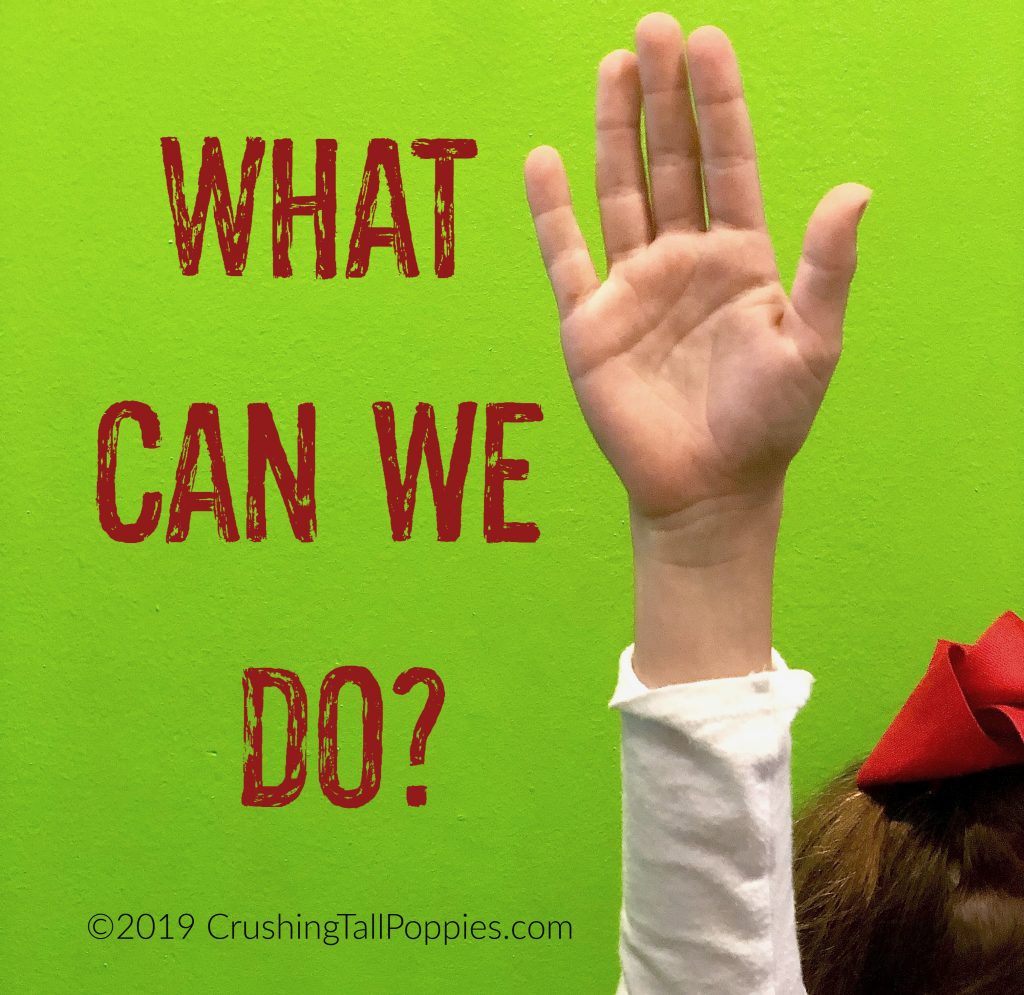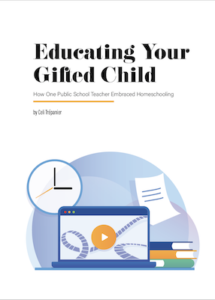How to NOT Shut Down a Gifted Child

In general, as water gets warmer, it takes up more space. Each drop of water only expands by a little bit, but when you multiply this thermal expansion of water over the entire depth of the ocean, it all adds up and causes sea level to rise.
What specific phenomenon is adding more water to the oceans?
She raised her hand and answered her teacher’s question correctly, and also excitedly adding other facts about global warming that troubled her.
What are glaciers, and where are they found?
She thrust her hand into the air again. Global warming and the environment was a topic she had been researching on her own for the last year.
If people keep adding greenhouse gases to the atmosphere, the average sea level around the world by the end of this century could rise by how many inches higher than it was in 2000?
Oh, she definitely knew this answer! This fact and its negative impact on humans triggered her anxiety almost daily.
The rising sea level is a threat to people who live near the ocean. Hundreds of millions of people around the world live in low-lying areas near the coast that could be flooded as sea level rises. What types of catastrophic damage could result from the rising sea level and stronger storms caused by warmer oceans?
As a gifted child, she was extremely sensitive and empathetic. The loss of land, homes, and human life due to global warming, at times, resulted in existential depression. She teared up as she raised her hand to give her teacher the grim answer.
What can we do to control global warming?
She had been researching the answers to this and had even planned a global warming campaign that she was hoping her school would allow to implement to help other students understand the imminent dangers of global warming. However, she was not called on to answer the question this time.
With her head turned towards the slide presentation on global warming, her teacher said, Anne, you are obviously an expert on global warming, but your classmates need a chance to answer these questions also.
The Shutting Down of Gifted Children in the Classroom
In my article, “When You Shut Down a Gifted Child, You Might Just Shut Down a Gifted Child—For Good,” we see how our gifted children can be passionate, hyper-focused learners and their enthusiastic engagement in topics of interest may cause disruption in the classroom. Shutting down a child’s intense interactions with learning in the classroom, although not intentional, can shut down their eagerness for learning for good. For gifted children or any child, the realization that their exuberant engagement in the classroom is unacceptable can result in significant negative emotional and educational responses. Many gifted children who have had negative experiences in the classroom due to their intense approach to learning have developed a growing disinterest in school, academic underachievement, and the loss of their love of learning. Reversing these emotional and educational consequences can be a steep, uphill battle once a gifted child has been shut down in school.
The multitude of responses to my original article reflected just how common and damaging the shutting down of gifted children in the classroom is. It was emotionally jarring for me to read the heartfelt stories about children who were humiliated, bullied, reprimanded, and shut down in school by teachers. From my experience as a former public school teacher, I offered a general but brief solution how to avoid shutting down a gifted child, or any child in my previous article, “When You Shut Down a Gifted Child, You Might Just Shut Down a Gifted Child—For Good.” Along with the many responses substantiating this all-too-common occurrence, I also received a few requests to elaborate on solutions and provide specific strategies to avoid shutting down gifted students in the classroom. What can we do to avoid shutting down our gifted students whose irrepressible pursuit of knowledge causes trouble in the classroom?

What Can We Do?
An Understanding of Gifted Students’ Behaviors in the Classroom
Understanding that gifted children can become overexcitable and hyper-focused when learning about topics for which they are intensely interested is a start. Educators need to be trained to recognize and appropriately address the unique emotional and educational needs of gifted children, as well as their extraordinary enthusiasm for learning. Being conscious that gifted children can approach their education in atypical and acutely emotional ways can help educators be more measured when managing these behaviors in the classroom. Teachers have quite a task maintaining discipline in their classrooms. Still, understanding that the gifted child in her classroom whose zest for learning is distracting is also extremely sensitive will help her handle the situation without shaming or shutting down the child. Being aware of the extraordinary emotional and educational characteristics of gifted children can help teachers prevent any harmful and even devastating effects when a gifted child’s behavior needs to be managed.
Instead of asking a gifted child in front of his classmates to curtail his questions and answers, talk to the child in private, and explain carefully and clearly why his behavior needs to be adjusted. Devising alternative ways for a gifted child to express his excitement for learning and sharing his knowledge can be the ideal accommodation, especially if the gifted child is a partner in creating the arrangement. Lastly, partnering with the gifted child’s parents in achieving the goal of managing the child’s enthusiasm while preserving her passion for learning can effectively secure the desired outcome—a classroom full of engaged learners.
Plan for Specific Questioning Methodologies in the Classroom
Students should know and understand the purpose of the questions being posed after a lesson. Be transparent about the learning outcomes expected and how it benefits them. For students, having a stake in their learning is critical. With each lesson, include the specific methods to be used for questioning while keeping in mind the abilities and proclivity of each student. There are many classroom questioning methods that provide a balanced, effective approach to engaging all students equitably while capturing their levels of comprehension and mastery.
On the website, Cult of Pedagogy, Jennifer Gonzalez, a former teacher, offers many pedagogical strategies for questioning and discussions after lessons. Here, I offer two that would allow an overly-enthusiastic gifted child the opportunity to satisfy his need to engage deeply in the lesson without having his enthusiasm for learning to be shut down.
1. Concentric Circles
Sitting in two circles, one inside the other, students are paired with another student. Once the teacher asks a question, the pairs collaborate and discuss to arrive at an answer with their partner. Each pair of students is given the opportunity to provide their collaborative answer. Then the circles rotate, and new pairs of students are formed, and the process is repeated.
2. Think-Pair-Share
This is similar to Concentric Circles, but pairs are planned in advance. Pairing students is a definitive opportunity to pair students with a suitable peer for a multitude of advantageous reasons. For gifted children, this method can allow them to interact with a like-minded peer to satisfy their need for a deeper connection to the information being taught. In my experience as a former classroom teacher and the mom of three gifted sons, I have seen gifted children used as tutors to help students who are lagging behind academically. Pairing a gifted child with a child in need of remediation with the expectation that the gifted child will help his partner understand the material is not an appropriate use of pairing students for collaboration; this also is a disservice to a gifted student.
The above are just two of many methods to direct and plan optimal question and answer sessions in the classroom to benefit all students and meet their specific learning needs. By planning classroom questioning methods ahead of time, gifted children whose penchant for throwing their hand up in the air and waving as if in a Fourth of July parade to answer every question asked, will understand the routine and the appropriate time for them to answer a question. Understanding that a question-and-answer session is not a free-for-all avoids humiliating and shutting down a gifted child in front of their classmates for their exuberance to express what they know.
Search the internet for other ways to plan specific classroom questioning methods that provide an equitable opportunity for every student to answer questions and express what they know without the fear of humiliation nor the risk of shutting a student down in front of their classmates. However, there are other ways to avoid shutting down a gifted child that can be handled privately and independent of their classmates.
Planning Independent, Child-Led Projects for Gifted Student
Many school districts do not provide adequate gifted education programming which leaves gifted children sitting in the regular classroom learning what they already know, and waiting for their classmates to catch up to what they have quickly mastered. Gifted children are known to require fewer repetitions to master a skill or information than their same-age classmates. Having the ability to work independently on a project of their choosing instead of sitting idly in the classroom can provide a gifted child an outlet for a more in-depth exploration of a topic for which they are passionate. An independent project can provide the depth, the acceleration, and the engagement a gifted student may need while satisfying their intensity for learning.
How a teacher implements and manages the process and outcome of an independent project depends on the individual needs of the gifted student. An extroverted gifted student who loves to gush with passion about topics for which she has an intense interest may be given the opportunity to present their independent project to her classmates. The gifted student who is more introverted and quiet may find discussing the process and end-product of his independent project with only his teacher more acceptable.
Whichever Methodology, It Must Meet the Educational and Emotional Needs of the Gifted Student
Whether it is planned, thought-out questioning methods, child-led independent projects, or another method of which there are many, the method chosen must meet the educational and emotional needs of gifted students in order to avoid shutting the down.
There is always a concern for educational equity within the classroom, and that is a tough balancing act for teachers. It then becomes an either-or decision in the classroom: attend to the struggling child with the required remediation or provide the needed acceleration and in-depth engagement the gifted child needs? We know from research studies, statistics, and anecdotal evidence that the educational needs of students who are academically behind are attended to while gifted children are left on their own. Because gifted children and their educational and emotional needs are all too often misunderstood, and it is also believed that gifted children will be fine learning on their own, this is often how equity is handled in the classroom—the gifted child is neglected in favor of remediating the failing student. This scenario does not have to be an either-or decision. It can be both—with proper planning.
Working with the parents of gifted children can ease the burden of having to attend to struggling students while addressing the accelerated and unique educational needs of gifted students. Ask the parents of gifted students to provide the materials needed for independent projects. These parents can also manage and guide the process of assigned independent studies. Parents of gifted children are most likely gifted themselves and may have a wealth of ideas on how they can work with their child’s teacher to meet the needs of their gifted student and other ideas on how to keep their gifted child engaged in school.
For more information, resources, and methodologies on how to not shut down a gifted child, check the resources below.
CITATIONS:
Sea Level: On the Rise. EPA—United States Environmental Protection. Agency. Accessed November 9, 2019
“Question Strategies.” Centre for Teaching Excellence. University of Waterloo. Accessed November15, 2019.
Gonzalez, Jennifer. “The Big List of Classroom Discussion Strategies.” Cult of Pedagogy, October 15, 2015. Accessed November 15, 2019.
Gonzalez, Jennifer. “In Praise of Think-Pair-Share.” Cult of Pedagogy, January 13, 2015. Accessed November 15, 2019.
Clayton, Heather. “The Art of Questioning: The Teacher’s Role.” Making the Standards Come Alive! Volume I, Issue III, 2012. Just Ask Publications and Professional Development. Accessed November 15, 2019.
Johnson, Ben. “The Right Way to Ask Questions in the Classroom.” Edutopia. October 30, 2013. Accessed November 15, 2019.
RESOURCES:
Trépanier, Celi. “When You Shut Down a Gifted Child, You Might Just Shut Down a Gifted Child—For Good.” Crushing Tall Poppies. November 1, 2019. Accessed November 15, 2019.
Trépanier, Celi. “A Gifted Child Checklist for Teachers.” Crushing Tall Poppies, June 9, 2014. Accessed November 15, 2019.
Trépanier, Celi. “Dear Teacher, My Gifted Child is in Your Class.” Crushing Tall Poppies. August 24, 2015. Accessed November 15, 2019.
Trépanier, Celi. “A Gifted Child Checklist for Teachers—A Shareable Presentation.” Crushing Tall Poppies, February 3, 2015. Accessed November 15, 2019.
Trépanier, Celi. “Gifted Children: What Parents Want Teachers to Know—A Free, Shareable Presentation About Gifted Children for Educators.” Crushing Tall Poppies. July 29, 2015. Accessed November 15, 2019.
 Crushing Tall Poppies
Crushing Tall Poppies



That level of enthusiasm was me on a tour of Drax power station, age 38. 🙂
It was fascinating and the tour guide was awesome. She said they also have tours for school trips and have the children sing songs to help them remember everything. One of the songs includes the trains going ‘choo choo’. One of the kids turned to her and said “Miss, these are Class 66 diesels. They don’t go choo choo”. And I thought my people. 🙂
Oh my gosh, I love that! I would have hugged that child immediately. There would have been no need for testing to see if that child was gifted!
Thanks for sharing that story and I love your reaction. Best thing I’ve read all day!
Thank You! I was one of those gifted kids. I remember asking my teacher once in a class if the story we were covering was going to do this and so later on in another chapter, and she said “Yes, but we’re (motioning to indicate the whole class) not there yet.” Then I knew I had a couple of classes to pause before they would be where I had already gone in my mind, if not the actual reading.
(I do this with storylines in movies too, though I know now that “Spoilers” are a thing to avoid so others can enjoy their movie experience.)
I never realized that teachers have strategies for the Q&A times, it always felt kinda random to me. Then again, it’s been 42 years since I was 8. Times have changed, which feels like a good thing. In the homeschool cooperative I taught at for a time, I allowed the kids to handle the figit toys I had brought in. I knew if I could get the hands of my ADHD/Gifted learners occupied, then their minds would have more freedom. It worked, the sense of relief on one student’s face told the story completely. It was something I had learned both from reading but also from the beautiful OT rooms that my youngest child had to utilize to get his body out of his own way. His teachers made room for this in his schedule and utilized special chairs in his classroom to help him to work on core strength while seated. That these strategies exist now are so important. Gifted kids and grownups too, can be pretty anxious and having tools to self soothe helps them to sleep better, and be happier campers sometimes.
So I guess what I’m saying is that good steps are being made. Still more ground to cover of course. Yet it feels like there’s hope overall.
There really are so many ways to reach all children if we just take the time. Teachers are overworked and too much is expected from them, but this can’t be the excuse to ignore the needs of gifted children.
Your thoughtful solution in the homeschool co-op where you taught was a great idea!
We may be moving the needle regarding the education of our gifted children, but not enough–yet.
Thank you for sharing a few of your experiences. It helps us to validate each other and to not feel so alone on this gifted journey! And thank you for your sweet comment on the Crushing Tall Poppies Facebook page! <3 ~~Celi